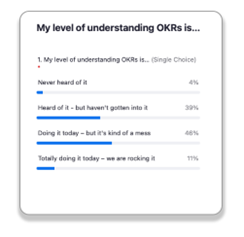Are Your OKRs Masquerading as Strategy + 4 OKR Secrets Revealed
This is one of our favorite topics! As OKRs continue to find their way into more strategic plans, we want to ensure you are using this plan structure to its full capability and avoiding the common pitfalls regarding OKRs. So, let’s jump in!
Survey Results: The Strategy Collaborative’s Understanding of OKRs
We ran this poll early in the session and wanted to share it. Many of you are already using OKRs, which is excellent! So, we will provide some OKR basics before jumping into the session content.

Resources to Cover the Basics of OKRs
We covered this briefly in our session, but we wanted to provide a few helpful resources on the basics of OKRs before jumping into the meat of the session. Here are a few valuable resources:
- Larry and Jeff cover the basics of OKRs from 11:00-18:47.
- Slides 6-10 in the presentation deck cover the basics of OKRs.
- Check out this helpful OKR cheat sheet.
- Here is a practical downloadable guide and canvas for creating OKRs.
- We’ve curated a playlist of OKR videos from our YouTube channel.
OKR Secret #1: OKRs MUST Deploy Your Organizational Strategy
Jeff and Larry explained from 18:55 to 25:45 using slides 12-15 that the best OKR models are aligned to and support these three things:
- Your organization’s vision +
- Your long-term strategic goals +
- Your lightweight 3-year roadmap
If you jump to OKRs and forgo the critical foundation of your strategic plan, you might end up with OKRs masquerading as strategy; that looks like OKRs that are unfocused, tactical in nature, and work that doesn’t support your long-term direction.
OKR Secret #2: Successful Cascading Requires Being Clear About “Why”
One of Larry’s most insightful “shares” was about the power of collaboration in cascading OKRs from 25:45-28:30 using the diagram on slide 16.
The secret to successful OKR cascades is to have leadership teams create shared, broad top-level organization-wide objectives and supporting key results that are annual in nature.
Then leadership and cross-functional teams collaborate to create the quarterly OKRs that support those shared annual OKRs. Collaborating helps everyone understand “why” their OKRs are essential in achieving the organization’s bigger direction. Specifically, everyone needs to know how their OKRs answer these key questions:
- What is it we want to achieve?
- How do we know we’ll accomplish that?
- How is everyone supporting the organization’s shared objectives?
The magic of this two-tiered model (organization-wide OKRs supported by team/individual OKRs) is that there is top-down and bottom-up cascading, collaboration, and communication.
OKR Secret #3: Alignment, Collaboration, & Shared OKRs Solve Three Major OKR Pitfalls
Larry insightfully shared three major OKR missteps and how to avoid them! Here’s why using OKRs to support your organization’s strategy, focusing on collaboration, and using shared OKRs can help prevent some painful missteps in deploying an OKR framework.
Misstep #1: Binding your OKR cascading to your organizational structure.
In this case, each functional department creates OKRs that support a company objective. It technically works, but it doesn’t allow collaboration between departments in your organization, nor does it allow cooperation among your leadership and functional teams. Larry’s explanation and diagram can be seen from 28:34-32:00 using slide 17 in the deck.
The fix: Create annual shared organization-wide OKRs, then collaborate cross-functionally to create quarterly individual/team OKRs.
Misstep #2: Not aligning OKRs to your overall strategy and direction.
In this scenario, departments create OKRs that aren’t aligned with your vision. And while this might be a short-term gain, it creates puddles of unfocused OKRs that won’t help your organization achieve its long-term goals. Larry and Jeff discuss this from 31:55-34:20 using slide 18 in the deck.
The fix: Start with your organization’s vision, long-term strategic goals, and lightweight 3-year roadmap. Use OKRs to deploy that strategy.
Misstep #3: Not using shared OKRs.
In plan structures and OKRs, fewer is better. If every leader in your organization creates 3-5 OKRs and has their team create supporting OKRs, you suddenly have 75-100 OKRs in your organization. And that creates an unfocused mess. Instead, using shared common goals and commitments at the organizational level establishes a plan that is smaller and more focused on what you want to achieve. Larry discusses this from 34:20-43:45 using slides 19-21 in the deck.
OKR Secret #4: OKRs are Best Paired with Quarterly Refreshes
This isn’t really a secret, but agility using OKRs requires reviewing and refreshing your plan quarterly! You need the flexibility to respond to changes in your organization so you can continue to deliver results to achieve your annual objectives. Larry and Jeff discussed this from 46:00-52:00 and provided an example OKR timeline on slide 23.
Choosing an OKR Software: Make Sure it Deploys Strategy!
Larry and Jeff touched on OKR software briefly during the session. There are lots of options when it comes to OKR software, but both Jeff and Larry agree that OKR software MUST deploy organizational strategy using OKRs. OnStrategy was created with this foundation in mind.
Questions We Answered
Katie H: How important is it that we set quarterly OKRs?
Larry’s Answer: It is essential to set quarterly OKRs, and that is going to require retooling an organization. Because you need to have the flexibility to respond and react to what’s happening in your organization quarterly. Because that is where agility is created.
Elizabeth B: How are OKRs different from KPIs?
Larry’s Answer: Take OKRs off the table. KPIs tell us the health of an organization for everything from customer service to sales. OKRs tell us what we need to achieve. OKRs often use KPIs to measure performance or inform us what the KPI target needs to be.
We’ve also written a pretty comprehensive post about this topic, which you can read here!












